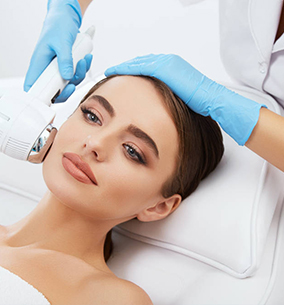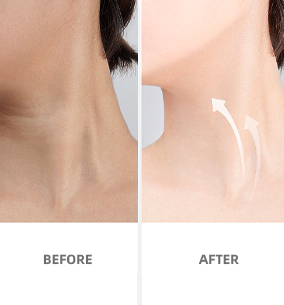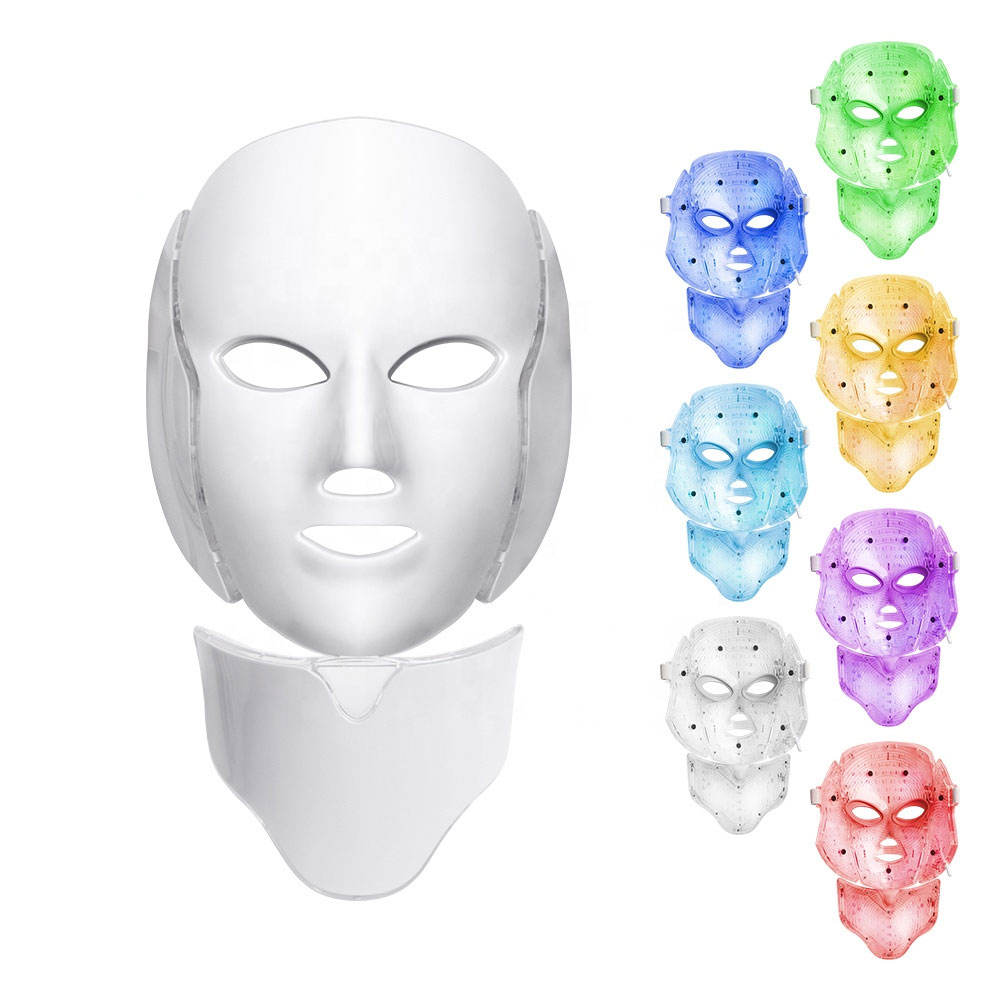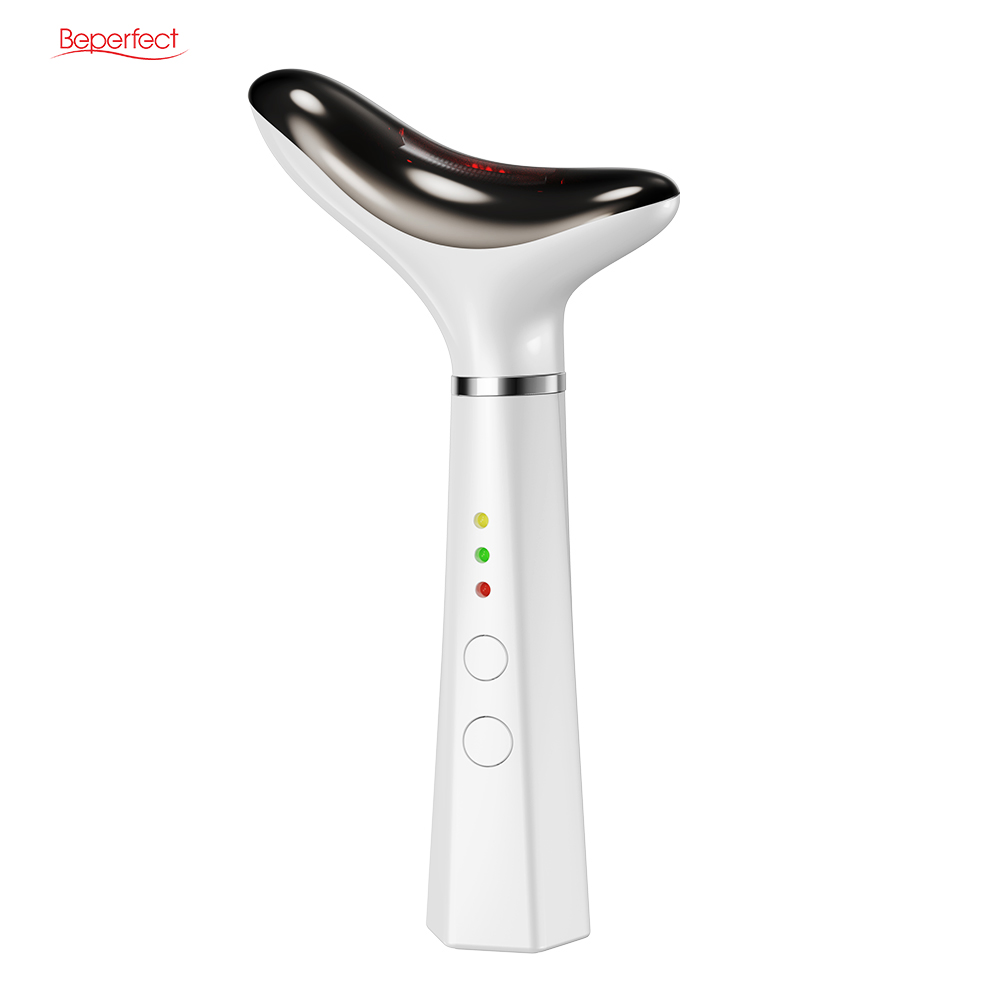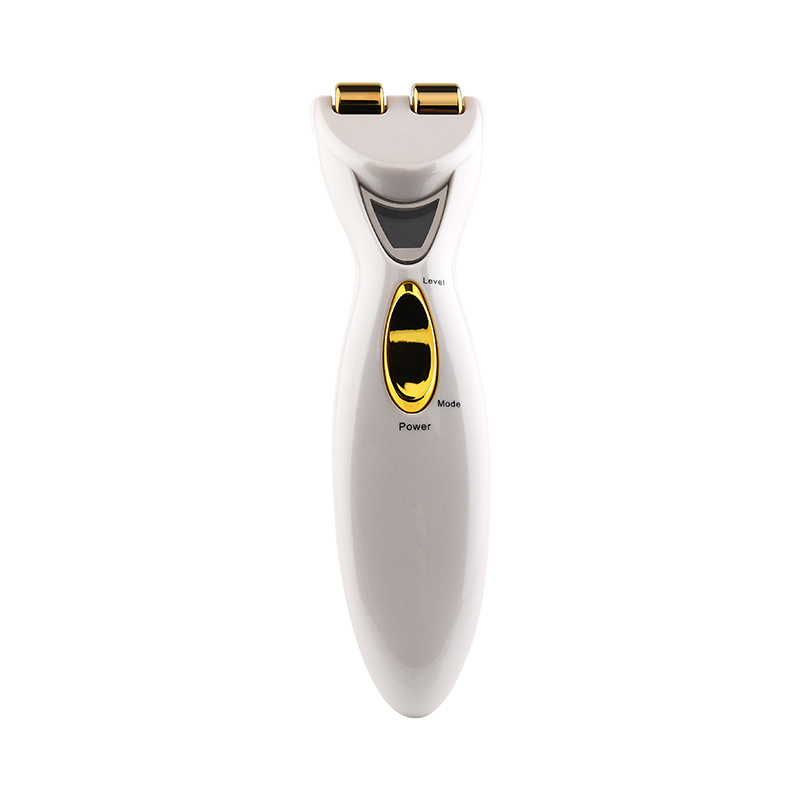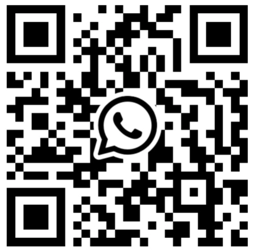Lifting & Tightening Devices
Discover our range of lifting and tightening products at BePerfect. Achieve firmer, youthful-looking skin with our clinically proven solutions. Shop now!
The look of loose skin around the lips, eyes, and jawline is a result of gravity's increasing impact on ageing. During video conversations, this might be especially apparent while gazing down from a laptop camera. Skin tightening procedures, also known as “non-surgical facelifts,” provide an easy way to lift and tighten the skin without requiring surgery. Skin needling, radiofrequency, laser, and ultrasound (HIFU) are among the possible methods for skin tightening. The optimal choice is determined by a number of variables. Targeting collagen, the fibres that keep our skin tight and elastic in our younger years, is the major goal of most of these therapies. Regretfully, the skin produces less new collagen annually beyond the age of 25, with a decline in collagen production as we age. In order to restore the skin's elasticity and strength, the main goal of skin tightening procedures is to encourage the synthesis of new collagen. Folloe us for more information about Lifting & Tightening devices.
What are lifting and tightening devices, and how do they contribute to skin rejuvenation?
Specialised instruments or technology used in skin rejuvenation treatments include lifting and tightening devices. By applying energy to the skin, these gadgets stimulate several physiological processes that increase the formation of collagen and increase the suppleness of the skin. They are able to efficiently lift and tighten loose or sagging skin by focusing on particular layers of the skin.
Typical kinds of lifting and tightening tools consist of the following:
- Ultrasound (HIFU): To heat the skin's deeper layers, High-Intensity Focused Ultrasound (HIFU) equipment uses concentrated ultrasound radiation. Over time, this hot energy tightens the skin by inducing a natural wound healing response that stimulates the creation of collagen.
- Radiofrequency (RF): Radiofrequency devices heat the skin by using electromagnetic radiation.
Heat causes collagen fibres to contract and promotes the synthesis of new collagen by penetrating the skin layers. Tighter, firmer skin is the result of this treatment.
- Laser: Lasers are devices that employ concentrated light beams to target particular skin layers. Abrasive and fractional lasers are two examples of the various kinds of lasers that may be used to tighten skin. Laser treatments stimulate the formation of new, healthier skin cells and collagen remodelling.
- Microneedling: Using tiny needles, microneedling devices pierce the skin. By inducing the skin's natural healing reaction, this procedure improves the texture and tightness of the skin by promoting the creation of collagen. To accelerate the rejuvenation process, topical serums or growth factors can be used in addition to microneedling. These lifting and tightening tools use a variety of energy sources and operate at varying depths to get their desired results. They aid in skin rejuvenation by producing a more youthful look, increasing skin elasticity, and decreasing sagging skin by inducing collagen formation and remodelling. It's crucial to remember that a person's skin type, the region being treated, and the particular device being utilised can all affect how successful these devices are.
what are the different types of lifting and tightening devices, such as radiofrequency devices, microcurrent devices, and laser treatments?
The various lifting and tightening device types are briefly explained here:
- Radiofrequency (RF) Devices: RF devices heat the skin's deeper layers by using electromagnetic waves. The creation of collagen is boosted by this heat, which results in tighter, more elastic skin. Cellulite removal, body contouring, and face rejuvenation are all possible using RF devices.
- Microcurrent Devices: These devices apply mild electrical currents to the muscles of the face. This method seeks to increase circulation, induce muscular contractions, and encourage the synthesis of collagen and elastin. Treatments using microcurrents can help tone and raise the muscles in the face, giving the skin a firmer, younger appearance.
- Laser Treatments: To address particular skin issues, laser treatments use concentrated light beams. A variety of lasers, including ablative and fractional lasers, are used to tighten skin. Fractional lasers tighten and stimulate the formation of collagen by inflicting minute lesions on the skin. Ablative lasers eliminate the skin's outermost layer, inducing a healing reaction that results in skin that is smoother and tighter.
- Devices for Ultrasound (HIFU): The deeper layers of the skin are heated using high-intensity focused ultrasound (HIFU) devices, which employ focused ultrasound radiation. This heat energy causes the creation of collagen, which tightens and lifts the skin. HIFU procedures are frequently utilised for body contouring, brow lifting, and non-surgical facelifts.
- Microneedling Devices: Using tiny needles, microneedling devices pierce the skin's surface. This procedure increases collagen synthesis and the skin's innate ability to recover. Microneedling can increase general skin renewal, minimise the appearance of wrinkles and scars, and improve the texture of the skin. It's crucial to remember that every kind of device functions differently and can be appropriate for treating particular skin issues or regions. The effectiveness and outcomes of various devices might differ, so it's best to speak with a dermatologist or skincare specialist to find the best choice for your unique requirements.
Compare at-home options with professional treatments, providing insights into the convenience and efficacy of each.
Convenience and effectiveness are significant considerations when comparing at-home choices with expert treatments. Below is a summary of each:
Options for at-home use:
- Convenience: with at-home choices, you may conveniently administer treatments on your own schedule, in the comfort of your own home. A plethora of at-home gadgets, lotions, and serums that promise to tighten and lift skin are frequently available. For best effects, you must, however, pay close attention to the directions and utilise these items as prescribed.
Efficacy: At-home solutions' levels of effectiveness might differ. Certain at-home gadgets, such as LED light therapy masks or microcurrent devices, could provide subtle changes to the texture and tone of the skin.
Nevertheless, in comparison to expert therapies, the outcomes could be more mild. While there is some evidence that creams and serums can temporarily tighten skin, their long-term ability to stimulate collagen formation and achieve noticeable skin tightening is limited.
Professional Treatments:
. Convenience: Getting professional treatments usually means going to a skincare facility or seeing a licenced practitioner. This might entail setting aside time for treatments and making appointments. Depending on the intended outcome and type of therapy, the number of visits will vary. Professional treatments generally offer a better degree of knowledge and more modern technologies, but they may also entail more scheduling work.
- . Efficacy: When compared to at-home alternatives, professional therapies administered by qualified and experienced specialists typically offer higher efficacy.
Clinic-based treatments, including radiofrequency, ultrasound, laser, and microneedling equipment, can provide more perceptible skin tightening and lifting by penetrating the skin deeper. These procedures can more efficiently promote the creation of collagen, which can result in notable changes in the suppleness and firmness of the skin. They are frequently tailored to address particular conditions.
How do lifting and tightening devices address common skin concerns like sagging, wrinkles, and loss of elasticity?
Through a variety of methods, lifting and tightening devices treat typical skin issues like sagging, wrinkles, and loss of elasticity. The way these gadgets address these particular problems is as follows:
- Stimulation of Collagen and Elastin Production: The skin's structure, firmness, and elasticity are provided by the proteins collagen and elastin. Sagging and wrinkles result from a reduction in these proteins' synthesis as we age. Several methods are used by lifting and tightening devices to promote the formation of collagen and elastin, including:
- Radiofrequency (RF) devices: these gadgets emit electromagnetic waves that cause heat to be produced in the skin's deeper layers. Over time, as a result of this heat-induced wound-healing response, the synthesis of collagen and elastin increases.
- Microcurrent devices: These gadgets produce low-level electrical currents that increase cellular activity and cause muscular spasms. This promotes tighter skin, increased synthesis of collagen and elastin, and improved circulation.
- Ultrasonic (HIFU) apparatus: The deeper layers of the skin are heated using high-intensity focused ultrasound (HIFU) devices, which employ focused ultrasound radiation. Skin tightening and lifting are the results of this heat energy's induction of collagen remodelling and synthesis.
- Muscle Stimulation and Toning: To enhance tone and firmness, certain devices, especially those that use microcurrents, target the muscles in the face. These devices work by stimulating muscular contractions with mild electrical currents. This can help lift and tighten drooping facial muscles, minimising wrinkles and improving overall face shape.
- Enhanced Blood Circulation and Oxygenation: Certain devices, such as those that use light therapy or thermal heating, can enhance skin oxygenation and blood circulation. Increased oxygen and nutrition reach the skin's cells as a result of this improved circulation, which also improves skin tone, suppleness, and cell regeneration.
- Exfoliation and Cell Turnover: Certain devices, such as microneedling machines, induce regulated micro-damages on the skin's surface, which promotes cell turnover and sets off a healing reaction. This procedure aids in enhancing the texture of the skin, lessening the visibility of wrinkles, and encouraging the development of fresh, younger-looking skin. Lifting and tightening devices can target and treat common skin issues, including sagging, wrinkles, and loss of elasticity, by using these principles. However, it's important to note that individual results may vary, and the effectiveness of these devices can depend on factors such as the device's technology, treatment consistency, and individual skin characteristics. Consulting with a skincare professional can help determine the most suitable device and treatment approach for your specific needs.
What is the science behind the effectiveness of these devices in achieving a more lifted and toned appearance?
The principles of skin physiology and the particular technologies used by lifting and tightening devices determine how efficient they are in producing a more lifted and toned appearance. The following are some important scientific ideas that underlie their efficacy:
- Collagen and Elastin Stimulation: The essential proteins that provide the skin with its suppleness and structural support are collagen and elastin. A variety of technologies, including ultrasound, microcurrent, and radiofrequency, are used by lifting and tightening devices to encourage the skin's natural synthesis of collagen and elastin. With the use of regulated heating or electrical currents, these technologies can initiate a wound-healing response that results in the production of new collagen and elastin fibres. This enhanced synthesis over time may result in tighter, firmer, and more lifted-looking skin.
- Muscular Stimulation and Toning: To enhance muscular tone and firmness, certain technologies, such as microcurrent devices, target the muscles in the face. Low-level electrical currents that imitate the body's normal bioelectrical impulses are sent using microcurrent technology. Muscle contractions induced by these currents can help tone and lift drooping face muscles. The skin surrounding the muscles looks tighter and lifted as the muscles are more toned.
- Cellular Energy and Metabolism: Some devices can affect the skin's cellular energy and metabolism, such as those that use light treatment. These gadgets employ red and near-infrared light wavelengths that enter the skin and interact with cells' energy-producing mitochondria. This connection can stimulate many cellular processes involved in collagen synthesis and skin renewal, as well as increase the creation of cellular energy and promote cell turnover. The skin may seem more toned and refreshed as a consequence.
- Mechanical Stimulation: Controlled micro-injuries are made to the skin's surface using microneedling devices. The skin's innate healing response is triggered by this mechanical stimulation, which causes the release of growth factors and the activation of cells that produce collagen. The texture and rigidity of the skin might improve with the formation of new collagen, giving the illusion of elevated skin.
What Are there any potential risks or side effects associated with the use of lifting and tightening devices?
Although lifting and tightening devices are usually regarded as safe when used appropriately, it is important to be aware of any potential hazards and adverse effects. These can change based on the particular gadget and personal circumstances. The following are some possible dangers and adverse consequences linked to using these devices:
- Skin Irritation: After therapy, some people may have transient skin redness, itching, or irritation. This may occur more frequently when using specific kinds of lasers or microneedling equipment. It normally goes away on its own in a few hours to a few days and is minor.
- Pain or discomfort: During certain procedures, patients may experience slight pain or short-term discomfort. Cooling methods or topical numbing lotions can be used to treat this. But each person has a different pain threshold, so some people could be more uncomfortable than others.
- Swelling and bruising: These side effects are possible, especially after more invasive procedures or ones that require deeper tissue penetration. Usually transient, this goes away in a few days or weeks, depending on the course of therapy.
- Hyperpigmentation or hypopigmentation: After treatment, there may be a chance of brief variations in skin pigmentation. This may show up as the treated region becoming lighter (hypopigmentation) or darker (hyperpigmentation). Although they are generally transient, these alterations may last for a few weeks or months.
- Burns or Blistering: Rarely, using the device improperly or at the wrong energy level might result in burns or blistering. To prevent such issues, it's imperative to adhere to the manufacturer's recommendations or seek expert advice.
- Seldom Occurring Complications: Although they are rare, more significant issues, including infection, scarring, or allergic responses, can happen. When therapies are administered by qualified specialists utilising sterile procedures and the proper protocols, these hazards are often reduced.
It's crucial to speak with a licenced dermatologist or skincare specialist prior to receiving any lifting or tightening procedures. In addition to discussing possible dangers and side effects, they may evaluate your skin type, medical history, and particular problems to decide the best course of action for you. Reducing the possibility of negative effects can be achieved by following the right aftercare guidelines and by continuing to practice excellent skincare.
How do these devices integrate into a comprehensive skincare routine for optimal results?
Incorporating lifting and tightening devices into a comprehensive skincare programme can enhance the efficacy of other skincare techniques. For best effects, incorporate them into a comprehensive skincare routine as follows:
- Cleanse and Prepare the Skin: To begin, gently wash your skin to get rid of any debris, pollutants, and leftover skincare products. To balance the pH of the skin and get it ready for treatment, use a toner afterward.
- Exfoliation: Regular exfoliation improves the uptake of active substances by removing dead skin cells. You can use chemical exfoliants (like AHAs or BHAs) or physical exfoliation (like mild scrubs) in your regimen, depending on your skin type and concerns. To minimise any irritation, do not exfoliate just before using a lifting and tightening device.
- Use lifting and tightening equipment: Adhere to the manufacturer's guidelines for the particular equipment you're using. It is generally advised to use the gadget on dry, clean skin. If necessary, use any conductive gel or serum that has been suggested. Focusing on the targeted treatment regions, move the device in a regulated manner in accordance with the device's instructions. Use it consistently, adhering to the suggested frequency and length of time.
- Apply Serums or Treatment Products: Use serums or treatment products that are appropriate for your skin issues after using the lifting and tightening device. Depending on whatever problems you are specifically targeting, look for products that contain components like retinoids, peptides, antioxidants, or hyaluronic acid. These items can improve skin health overall, collagen formation, and hydration.
- Moisturise: To maintain the skin's barrier function and seal in hydration, use a moisturiser that is appropriate for your skin type. To hydrate and shield the skin, look for moisturisers that contain ceramides, humectants, and emollients.
- Sun Protection: Even with lifting and tightening technologies, you still need to shield your skin from damaging UV radiation. Use an SPF-appropriate broad-spectrum sunscreen to protect your skin from UV rays. This is an essential step in order to preserve the benefits of using the gadget and avoid premature ageing.
- Additional skincare stages: You may add other stages to your regimen, such as eye creams, masks, or specialised treatments (like those for acne or hyperpigmentation), depending on your skincare requirements. Recall that consistency is essential. Over time, effects can be optimised with consistent and regular usage of the lifting and tightening device in conjunction with a comprehensive skincare regimen. Furthermore, it's advantageous to speak with a dermatologist or skincare specialist for individualised counsel and direction on incorporating these tools into your skincare regimen in accordance with your unique requirements and objectives.
Can lifting and tightening devices be used on all skin types and tones?
Many skin types and tones can benefit from the use of lifting and tightening devices; however, take into account the following:
- Sensitivity: Exercise caution while using sensitivity and modify intensity as necessary.
- Skin Conditions: Avoiding or modifying device use may be necessary for certain conditions.3. Fitzpatrick Skin
- Types: When using heat- or light-based devices, darker skin tones may need to exercise caution.
- Adhere to the device's guidelines: Read the manufacturer's directions and abide by them.
- Consult a specialist: For individualised guidance and safety, seek the assistance of a dermatologist or skincare specialist.
- It's crucial to speak with a skincare expert to guarantee safe and efficient use, depending on your unique requirements.
What features should users consider when selecting a lifting and tightening device for personal use?
To keep young skin, select the best anti-ageing skin-tightening equipment for your house. With the use of cutting-edge technologies like thermal heating, red light therapy, and microcurrent, these devices can increase the synthesis of collagen and elastin, giving the skin a tighter, firmer texture. When choosing an anti-ageing gadget, keep the following important considerations in mind:
- Technology Applied: Ascertain which technology, or technologies combined, the gadget uses. Cryotherapy, thermal heating, red light treatment, EMS, and microcurrent are popular choices. For better outcomes, look for gadgets that integrate several different technologies.
- Treatment Areas: Think about the particular regions you wish to focus on. Certain devices target wrinkles, fine lines, and sagging skin just on the face. Some focus on addressing eye conditions such as hooded eyelids, crow's feet, and under-eye bags. In addition, there are gadgets for the body and face, as well as complete choices that address every aspect of ageing.
- Ease of Use: It's critical to select a device that is easy to use because you'll be utilising it at home. Search for gadgets with an easy-to-use interface or display screen, customisable treatment options that can be adjusted, ergonomic and lightweight design, cordless and rechargeable functioning for flexibility, automated shut-off for safety, and thorough manuals or training videos.
- Safety and Quality: Give top priority to gadgets from reliable manufacturers that are well-known for their high standards of both. Examine client testimonials and look for regulatory body certificates or authorizations.
- Budget: Take into account both your financial situation and the device's value. To choose a product that satisfies your skincare needs and falls within your budget, compare features, costs, and reviews. By taking these things into account, you may select an anti-ageing skin-tightening tool for your house that fits your particular skincare preferences and goals, enabling you to easily get youthful, glowing skin from the comfort of your home.
What are usage practices to help users maximise the benefits of lifting and tightening devices while ensuring safety and efficacy?
Use these procedures to ensure the safety and effectiveness of lifting and tightening devices and to optimise their benefits:
- Read and abide by the instructions and rules provided by the device.
- To maximise touch and efficacy, start with dry, clean skin.
- If your skin is sensitive, do a patch test.
- For a smooth application, use the conductive gel or serum that is indicated.
- Use the gadget as directed, being careful not to apply too much pressure.
- Maintain consistency by following the suggested duration and frequency.
- To avoid irritating or damaging your skin, don't overdo it.
- Follow the manufacturer's recommendations for cleaning and maintaining the equipment.
- Keep an eye on your skin's reaction and stop using the product if negative side effects appear.
- Include the gadget in a thorough skincare regimen.
Consult a specialist if necessary, as the safety and efficacy of devices might differ depending on personal factors.

